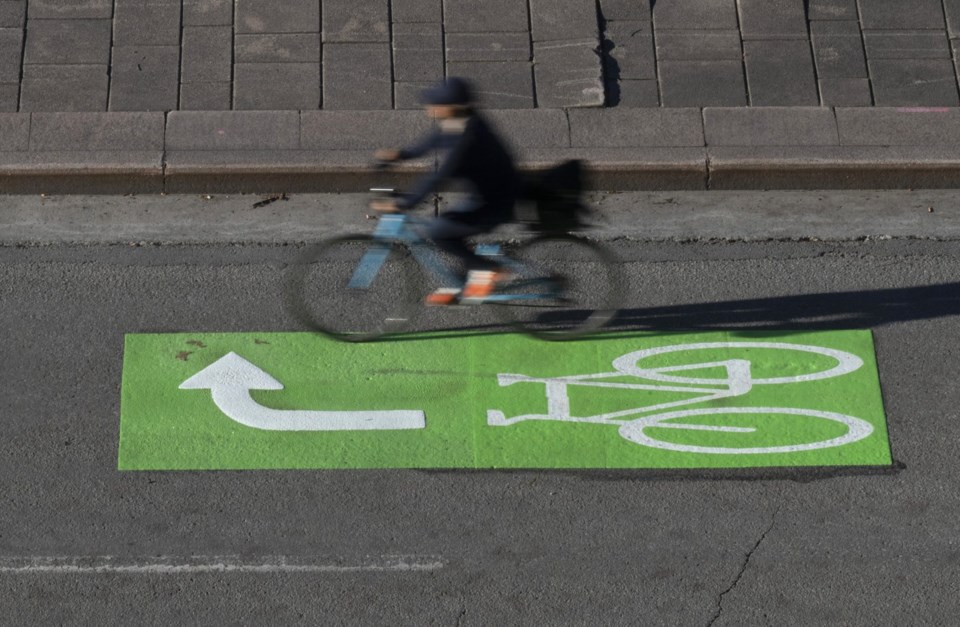HALIFAX — Nova Scotia Premier Tim Houston is threatening to overrule Halifax city council's efforts to create a new bike lane — drawing criticism he's unnecessarily meddling in municipal matters.
The proposed cyclist path on Morris Street — lined with homes, small apartment buildings and a few businesses — would remove one direction of traffic and link the bike lanes from the city's waterfront to a district of hospitals and universities.
However, Houston told council in a letter that the plan would cause traffic congestion, create public safety risks and potentially jeopardize truck transport from the nearby port. "To say that I find it disappointing that public safety and economic impact concerns have been dismissed with a simple shrug of the shoulders would be a serious understatement," the premier said.
Houston said his government could use legislation passed in the spring — but which has yet to enter into force — granting it the power to set transportation policy for municipalities.
He cited a letter to the city from Emergency Medical Care Inc., which provides ambulance service, suggesting the lane closure “may result in longer travel distances, rerouting of response vehicles and potential delays in reaching scenes or hospitals.”
PSA Halifax, the operator of the container terminals at the port, said in a letter to the city that Morris Street is a “critical alternate route for port-related traffic,” especially when a waterfront road is closed or congested.
Council recently doubled down on its project, defeating a motion 13-4 last week to consider alternative cycling connections for Morris Street.
Coun. Kathryn Morse, who supports the bike lane, said in an email that staff consulted with the port and ambulance service before recommending the project and that red flags weren't raised. As well, she said there are efforts to shift container traffic from the port to the railway, reducing the need for Morris Street as an alternative conduit for port traffic.
Houston, she added, is using the bike project as justification for giving Mayor Andy Fillmore — who has expressed concerns over the bike lane — more powers over council.
Houston said last week that his government is looking at strengthening mayoral powers, citing a disconnect between the needs of residents and the recent decisions taken by Halifax council.
Claudia Chender, the leader of the NDP, said in a statement Thursday that Houston should focus on looking at ways to reduce traffic congestion. "Instead of constantly trying to consolidate power, the premier should stay in his lane,” she wrote.
Tom Urbaniak, a professor of political science at Cape Breton University, said in an interview that Houston's latest move is an example of the province's Tories taking their cue from Ontario Premier Doug Ford's Progressive Conservatives.
In 2022 Ontario began granting more power to mayors. Now 215 mayors and heads of councils can propose bylaws and pass them with the support of one-third of councillors. They can also veto bylaws and hire and fire department heads.
Ford's government also gave itself the power last year to remove 19 kilometres of protected bike lanes over the objections of the city. And it passed a law requiring cities to seek provincial approval to install new lanes that cut into vehicle traffic.
"It's almost a truism now in Nova Scotia that if you want to predict what the Nova Scotia government will do, look at Ontario and that's Nova Scotia 18 months from now. We've seen that across a range of policy areas, whether it's provincial planning powers or bike lane intervention," Urbaniak said.
However, Urbaniak said Houston may find the populist strategy creates challenges because citizens will soon ask what his government is doing to solve the complex issue of traffic congestion on the Halifax peninsula.
Halifax's plan for bike lanes envisions a 53-kilometre network across the city; as of March 2025, 29 kilometres of the network has been built, costing $15.8 million.
A spokeswoman for the city said in an email that the cost of the Morris Street bikeway "could range between $300,000 and $800,000, depending on its final design. "Overall, impacts to the (traffic) network were not expected to be significant," Laura Wright said. "However, some intersections would be expected to see a potential increase in delay."
This report by The Canadian Press was first published July 17, 2025.
Michael Tutton, The Canadian Press



